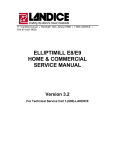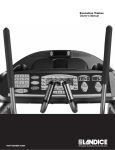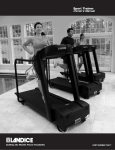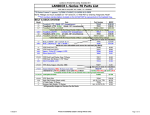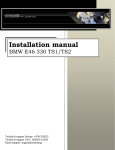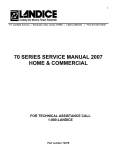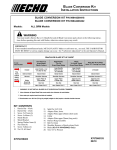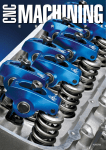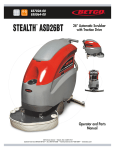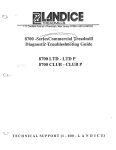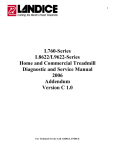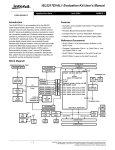Download Elliptical E7 / E950 Home & Commercial Service Manual
Transcript
1 LANDICE, INC. 111 CANFIELD RD., SUITE A-1 RANDOLPH, NJ 07869 PHONE: (973) 927-9010 FAX: (973) 927-0630 [email protected] ELLIPTICAL E7 / E950 HOME & COMMERCIAL SERVICE MANUAL Starting with Serial # E010004 Version 3.2 For Technical Service Call 1-(800)-LANDICE, Ext. 170 EMAIL: [email protected] 8-31-15 2 Table of Contents Service Manual Version 3.2 Pages 2-3……………………..Table of Contents SECTION 1 –WARRANTY INFORMATION Pages 4-8..………………..…..Replica WTY Cards & Warranty Policies Page 9……………………...…Service Authorization Claim Form SECTION 2 - INSTALLATION Page 10……………………….Tools needed for Installation and Repair Pages 11-13...............................Safety Instructions Page 14……………………….Electrical Requirements for E-Series Elliptical Page 15-18……………………Assembly Instructions SECTION 3 – PARTS IDENTIFICATION Page 19………………………..E-Series Elliptical Dimensions & Weight Pages 20-21……………………E-Series Control Panels and Features Page 22………………………..Accessing Diagnostic Features on Elliptical Consoles Pages 23-26……………………Definition of Parts SECTION 4 – SERVICING LANDICE ELLIPTICALS Pages 27-29…………………….Testing Components Pages 30….…………………….Relay board, LED Configuration and Function Pages 32…….………………….Display Button Feedback Page 33…………………….….. Membrane Bypass Test Pages 34-35…………………….Heart Monitor Diagnosis Pages 36-40…………………….Removal and Replacement of Crankshaft and Frame Bearings Pages 41-43…………………….Removal and Replacement of Magnet Brake and Brake Cable Pages 44-45…………………….Removal and Replacement of Brake Motor Pages 46………………………..Flowchart Section - Use to diagnose common problems Page 47 ………………………...Flowchart – Unit Won’t Turn On Page 48…………………………Flowchart – No speed feedback Page 49…………………………Flowchart- PO error, No Resistance, Error in Brake Controller Page 50…………………………Wire Schematic Page 51…………………………Main Wire Harness Page 52-60...…………………....High-Tech Entertainment Center Diagnostic Addendum. Page 62…………………………Voltage Readings for High-Tech Center Page 63…………………………Fan/Speaker not Working Page 64…………………………Fan will not turn on Page 65…………………………Fan runs at one speed Page 66…………………………Display turns on but no sound from speakers 3 SECTION 5- PARTS EXPLOSIONS AND PARTS LIST Page 67…………………………..Parts Explosion Page 68………………………..…Frame and Shroud Explosion Page 69…………………………..Uprights, Contact Heart Rate, Handlebars Page 70…………………………..Lower Electronics Page 71…………………………..Stride Components Page 72…………………………..Crank Arm and Pedal Tubes Page 73…………………………..Brake Wheel Components Page 74…………………………..High Tech Center Components Pages 75-80………………………Parts List SECTION 6 RETROFITTING LVS Pages 81-83……………………….Retrofitting Landice LVS to an Elliptical (2nd Generation) 4 5 6 LANDICE WARRANTY AND POLICIES The Service Warranty covers installation of parts shown to be defective in material or workmanship. The selling dealer is responsible for labor for ellipticals needing repairs. A Service Authorization (SA) number must accompany any service reimbursement request. Service Authorization numbers are given when the selling dealer or the service technician calls Landice prior to beginning work on the elliptical. This allows Landice to verify that the elliptical is within the labor warranty and also aids us in helping the technician troubleshoot the elliptical. Landice welcomes technicians to call us from the field and gives these calls the highest priority. This Service Warranty does not cover customer instruction, installation, setup, or maintenance. Line Cords (power cords) are also not covered by this warranty as these can only be damaged by misuse or abuse. This warranty does not cover cosmetic damage, damage due to acts of God, accident, misuse, abuse, or negligence of the product. The part will be covered in full only if it exhibits evidence of a manufacturing or material defect during the warranty period. Please keep in mind, “negligence of the product” includes damage inflicted by using the elliptical in an improper fashion. 7 SERVICE REIMBURSEMENT POLICY: This is offered to all Landice dealers as well as all authorized Landice service providers. Landice covers our ellipticals with a 1-year labor reimbursement policy. That means we will pay to fix our ellipticals as long as it’s within one year from the date the elliptical was purchased. OUR POLICY: Landice will reimburse the selling dealer according to our labor rate schedule. If you are a service provider for Landice and do not sell our product, you have the option of billing us direct or you can bill the dealer that you are providing service for. Generally, if our capped rate does not cover your labor charge you would bill the selling dealer. The current rate is $30.00 per hour and is capped at a maximum of one hour labor and one hour travel per elliptical failure. Diagnostic and return trips are not covered. If parts were credited out or Invoice was partially paid, the claim will be denied. Note that set-up procedures are not covered by this warranty. Set-Up Includes: Assembly, replacing parts due to cosmetic damage or abuse, and performing any additional adjustments that may have been upset during shipping. The dealer must call for a service authorization number prior to performing any service to verify the elliptical is under labor warranty. It is advisable to call Landice from the elliptical location to successfully diagnose the problem. This will insure that the correct part will be shipped out the first time. Labor claim forms must be submitted within three months from the date service was performed. Labor claim forms must be completely filled out and have the Landice Service Authorization number at the top. Generally service claims are paid out upon the return of defective parts and/or crediting of the warranty invoice. If parts are outstanding for a period of more than 90 days previously submitted service claims will be returned unpaid. FLOOR MODELS AND DEALERS STOCK: If the dealer sells an elliptical to a customer within one year of its purchase from Landice, the warranty period will be extended to start from the date of sale to the customer. If a residential elliptical is over 1 year old when sold to a customer, the elliptical will carry a 5 year parts warranty and there will be NO labor warranty. If a commercial unit is over 1 year old when sold to a customer, the elliptical will carry the remainder of the parts warranty from the date of shipment with NO labor warranty. 8 PARTS POLICY Our policy requires that all defective parts be returned to Landice. All warranty parts will be billed to the dealer at dealer cost. Landice will credit this invoice upon receipt of defective parts. It is the dealer's responsibility to return the defective parts to Landice with a copy of the invoice or packing slip. If the defective parts are not returned within 30 days, payment of invoice is expected in full. WARRANTY PART ORDERING: When you order parts under warranty please have the following information available. Warranty orders cannot be processed without this information: 1) Customer's name, address and phone number 2) Elliptical serial number 3) Detailed description of failure PURCHASE PART ORDERING: Serial numbers are recommended to help ensure the correct part is shipped. Purchased parts are covered by a 90 day replacement part warranty from the date the order shipped. 9 LANDICE, INC. 111 CANFIELD RD., SUITE A-1 RANDOLPH, NJ 07869 SERVICE CLAIM FORM DEALER INFORMATION: Service Dealer / Dealer Name: Address City Phone( Contact PHONE: (973) 927-9010 FAX: (973) 927-0630 [email protected] SA# State Zip State Contact Zip ) CUSTOMER INFORMATION Name Address City Phone( ) ELLIPTICAL/TREADMILL INFORMATION Model Type: Frame Serial # DCP Serial # (if applicable) Out of box problem Yes No Date of Service Date of Purchase CUSTOMER COMPLAINT SERVICES PERFORMED/PARTS REPLACED TRAVEL / LABOR: Travel Time: Labor Time: VALIDATION SIGNATURES Service Rep. Signature TOTAL TIME: _________ Date Customer Signature IN ORDER TO PROCESS THIS CLAIM IN THE LEAST AMOUNT OF TIME, SEND THE SERVICE CLAIM WITH THE DEFECTIVE WARRANTY PART. DO NOT SUBMIT SERVICE CLAIMS WITHOUT SERVICE AUTHORIZATION NUMBERS. 10 RECOMMENDED TOOLS FOR SERVICING LANDICE ELLIPTICALS 1. 4-18mm Allen Key socket or wrench set 2. 4-18mm wrenches 3. 3/8 to 7/8 standard socked and wrench set 4. Ratchet & Extension 5. Vise Grips 6. #1, 2, or 3 Phillips Head Screwdriver or power bits 7. #1, 2, or 3 Flat Head Screwdriver or power bits 8. Cordless or Corded Drill 9. Rubber Mallet 10. Diagonal cutters/Dykes 11. Wire Stripper 12. Wire Cutters 13. Digital Multimeter (Analog meters are not recommended) 14. C-Clamp or Pressure clamp (12” span) 15. Snap ring pliers 16. Flat tip punch set 17. Sandpaper 18. Two 12” long 2x4 pieces of wood 11 IMPORTANT OPERATING SAFETY INSTRUCTIONS WARNING: Failure to observe the following operating instructions can result in serious injury! [1] If you are suffering from any illness, condition, or disability which affects your ability to run, walk or exercise, do not use this product without consulting your doctor first. [2] If you are suffering from any illness, condition, or disability which affects your ability to run, walk or exercise, do not use this product without supervision present. Failure to do so may result in serious injury should you fall while the machine is in motion. [3] Failure to leave ample clearance around the elliptical could result in the user becoming trapped between the mechanism and a wall, resulting in serious injury. Allow a minimum clearance of 6 inches on each side of the elliptical. Allow a minimum clearance of 1 foot at the rear of the elliptical. [4] Be sure to familiarize yourself with the owner’s manual. Look it over carefully. Be sure you understand the control panel operation before using the elliptical. When using an electrical appliance, basic precautions should always be followed. Read all instructions before using. DANGER: Always unplug the elliptical before cleaning or removing any shrouds. To reduce the risk of electrical shock in the event of an electrical storm, always unplug the elliptical from the electrical outlet after using. 12 IMPORTANT OPERATING SAFETY INSTRUCTIONS WARNING: To reduce the risk of electrical shock or injuries to persons: [1] An appliance should never be left unattended when plugged in. Unplug from outlet when not in use. [2] Close supervision is necessary when this unit is used by or near children or disabled persons. [3] Use this elliptical only for its intended use as described in this manual. [4] Never operate this elliptical if it has a damaged cord or plug, if it is not working properly, or if it has been damaged. Call your selling dealer immediately for examination and repair. [5] Keep the power cord away from heated surfaces. Be sure the line cord has plenty of slack and does not get pinched underneath the elliptical. [6] Never drop or insert any object into any opening. Be sure no objects are near or underneath the elliptical [7] Do not operate where aerosol (spray) products are being used or where oxygen is being administered. [8] Connect this appliance to a properly grounded dedicated outlet only. [9] To disconnect, press the OFF button, and unplug the unit from the wall outlet. 13 GROUNDING INSTRUCTIONS This product must be grounded. If it should malfunction or break down, grounding provides a path of least resistance for electric current to reduce risk of electrical shock. This product is equipped with a cord having an equipment grounding conductor and a grounding plug. The plug must be plugged into an outlet that is properly installed and grounded in accordance with all local codes and ordinances. 120 VOLT ELLIPTICALS Ellipticals marked 120 VAC are intended for use in a nominal 120-volt circuit with a grounding plug. Make sure the product is connected to an outlet having the same configuration as the plug. No adapter should be used with this product. 200 – 250 VOLT ELLIPTICALS Ellipticals marked 200 – 250 VAC are intended for use on a circuit having a nominal rating more than 200V and are factory-equipped with a specific cord and plug to permit connection to a proper electric circuit. Make sure the product is connected to an outlet having the same configuration as the plug. No adapter should be used with this product. If the product must be reconnected for use on a different type of electric circuit, qualified service personnel should make the reconnection. DANGER: Improper connection of the equipment-grounding connector can result in a risk of electric shock. Check with a qualified electrician or serviceman if you are in doubt as to whether the product is properly grounded. Do not modify the plug provided with the product. If it will not fit in the outlet, have a proper outlet installed by a qualified electrician. 14 ELECTRICAL REQUIREMENTS FOR E-SERIES ELLIPTICAL All Ellipticals are automatically rated for 110 or 220 VAC with no external transformer. The power supply will know what voltage it’s receiving and will bring it to a 12Vdc supply to power the upper console. 110 VAC ELLIPTICAL PLUG HOME & COMMERCIAL ELECTRICAL REQUIREMENTS: 110 VAC, 60 HZ, 15 AMP - DEDICATED CIRCUIT & GROUND PLUG - NEMA 5-15P (PLUG) RECEPTACLE - NEMA 5-15R (RECEPTACLE) 220 VAC CLUB & INTERNATIONAL PLUG 220V CLUB & INTERNATIONAL ELECTRICAL REQUIREMENTS: 220 VAC, 60 Hz, 15 AMP - DEDICATED CIRCUIT & GROUND PLUG - NEMA 6-15P (PLUG) RECEPTACLE - NEMA 6-15R (RECEPTACLE) E7/ E950 ASSEMBLY INSTRUCTIONS 15 E7/ E950 ASSEMBLY INSTRUCTIONS 16 17 E7/E950 LVS Instructions *** (includes iPod Video Cable Option) *** 1. Use a ½” socket to secure the bracket from the underside of the pod. The hardware is attached to the bracket. 4. Feed the power cord down the right upright leg to the base. You may have to jiggle the cord to make it thru the access hole. 2. Insert Power, Cable line and *iPod cable* connections into the back of the TV. 5. Run the power cord along the frame and rest it on the ground. 3. Feed the power cord from the bracket thru the access hole at the bottom of the upright. 6. Feed the cable line and *iPod Cable* from the base of the bracket into the pod through the 1¼” access hole. 7. If you have an iPod Cable, then connect the headphone plug to the available jack on the inside of pod. 8. If you have an iPod Cable, then feed the docking connector through the pod and reinsert the black plastic access cap. 9. Feed the cable line down the left upright leg thru the access hole at the base. 18 10. Connect the cable line to the inside of the motor cover before securing it. Then mount motor cover to frame 11. Connect one female end of the “Y-shaped” AC power splitter into the main power outlet located at the motor cover. Connect the other female end into the power cord from the LVS TV. Connect your line cord into the male end of the AC power splitter. 19 20 E7/E9 ELLIPTICAL CONTROL PANEL & FEATURES EXECUTIVE ON ALL E7 & E9 MODELS Production Date: July 6, 2010 Serial# E0-10026 Control Panel Features: 8.5 inch computer-animated video display, Chest Strap and Contact Heart Rate Crossbar, 5 Built-in programs, 5 User-defined programs, 6 Fitness Tests: Balke, Firefighter, Army, Navy, USMC & USAF Electronics: Relay board, Brake controller. Home & Commercial Settings: Level 1-20 Effort Levels, MPH, REV/MIN, or KMH CARDIO ON ALL E7 & E9 MODELS Production Date: February 12, 2008, Serial# E0-10020 Control Panel Features: LCD Display windows, Chest Strap and Contact Heart Rate Crossbar, 5 Built-in Programs, 5 User-defined programs, 3 Fitness Tests: Balke, Firefighter, & Army, 2 Built-in heart rate monitoring programs, 2 User-defined heart rate monitoring programs. Electronics: Relay board, Brake controller. Home & Commercial Settings: Level 1- 20 Effort Levels, MPH, REV/MIN, or KMH. 21 PRO SPORT ON ALL E7 & E9 MODELS Production Date: February 12, 2008, Serial# E0-1001 Control Panel Features: LCD Display windows, Chest Strap and Contact Heart Rate Crossbar, 5 Built-in Programs, 5 User-defined programs, Electronics: Relay board, Brake controller. Home & Commercial Settings: Level 1- 20 Effort Levels, MPH, REV/MIN, or KMH. PRO TRAINER ON ALL E7 & E9 MODELS Production Date: February 13, 2008, Serial# E0-10004 Control Panel Features: LED digit display, Chest Strap and Contact Heart Rate Crossbar, 5 Built-in Programs, 2 User-defined programs. Electronics: Relay board, Brake controller. Home & Commercial Settings: Level 1-20 Effort Levels, MPH, REV/MIN, KMH. 22 Accessing Features on the E7/E950 Elliptical To access functions, turn Elliptical off and press and hold first button listed then press next button listed. Release ALL buttons at same time to access feature. Executive Trainer 2 1) MENU / START Diagnostic mode & Open Loop 2) MAIN MENU, go to SETUP, go to UNITS Configures Metric or English 3) UNITS ( - ) / PAUSE / START Reboots 4) With unit off, press in this order: top left & top right center screen buttons and the START button at the same time. Resets hours and miles Cardio Trainer 4 1) ENTER / START Diagnostic mode & Open Loop 2) Display (+) & (-) / START Self-Diagnostics 3) MANUAL / PROGRAMS / START Configures Metric or English 4) UNITS (-) / PAUSE / START Reboots 5) 1 / 5/START Resets hours and miles Pro Sport Trainer 4 1) ENTER / START Diagnostic mode & Open Loop 2) Display (+) & (-) / START Self-Diagnostics 3) MANUAL / PROGRAMS / START Configures Metric or English 4) UNITS (-) / PAUSE / START Reboots 5) 1 / 5/START Resets hours and miles Pro Trainer 2 1) DISPLAY / START Diagnostic mode 2) Speed (+) / START Open Loop Speed 3) SPEED (-) / ELEVATION (-) / START Configures Metric or English 4) PAUSE / START Display Software version 5) WEIGHT INPUT / PAUSE / START Reboots 23 DEFINITION OF PARTS Amplifier An amplifier is an electronic device that filters sound and allows volume control through the speakers on the High Tech Entertainment Center. Brake Motor The brake motor controls the resistance level of your work out. Brake Motor Cable (External) The brake motor cable (external) attaches to the brake motor and magnetic flywheel. This cable pulls on a nylon piece inside the magnetic flywheel to increase/decrease resistance when the brake motor engages. The cable will move internal components inside the brake wheel to adjust your resistance. Brake Motor Cable (Internal) The brake motor cable (internal) moves magnetic brake shoes inside the flywheel to increase/decrease the level effort. Brake Motor Harness The brake motor harness attaches to the brake motor and relay board. This harness transfers voltage and data between the relay board and brake motor for level effort change. Crank Arm The crank arm attaches to the crank shaft and stride arm assembly. This arm coordinates the movement of the stride arm with the crank shaft. Crank Arm Cap The crank arm cap covers the top of the crank arm and bearing. Crank Bearing The crank bearing is part of the crank assembly. The crank side arm attaches to the bearing for stride movement. Center Drive Shaft Assembly The center drive shaft assembly provides clockwise and counterclockwise rotation for stride movement. This assembly consists of pedal rollers, crank bearings, nylon sleeves and locking collars. Control Heart Rate Crossbar (CHR) The contact heart rate handgrip will provide the user heart rate reading during use. Drive Belt The drive belt rotates the drive pulley assembly and braking system. 24 Drive Pulley Assembly The drive pulley assembly allows the center drive shaft assembly to rotate. This consists of a spindle and magnetic disc for the speed sensor. Drive Wheel Assembly The drive wheel assembly attaches to the arm pinion and crank assembly. The assembly will run concurrently with the crank shaft. This does not have the drive belt. Faceplate The faceplate overlay is found on the Pro Trainer model and is screwed onto the upper display board. Fan The fan blows cool air during workouts. This is attached inside the high tech entertainment center. Fan Control Buttons The fan control buttons allow the customer to control the fan speed. Footpad The footpad (gel insert) is the cushion inside the pedal. Harness, Main upper The upper harness transmits data from the upper board to the relay board. HRC Dual Receiver The HRC dual receiver takes transmission signals from the chest strap or CHR crossbar and converts it to a digital signal to display heart rate info on the upper console. Isolation Damper The isolation damper is a nylon piece that isolates the crank arm from the crank bearing to prevent metal on metal noise. Leveling Feet The elliptical has 6 leveling feet to level the equipment and prevent it from rocking. Line Cord The line cord supplies power from the wall outlet to the elliptical. Locking Collars The locking collars slide onto the nylon spacers to lock them down and prevent the crank bearing or pedal roller from moving left or right while the machine is in use. Magnetic Brake Wheel The magnetic brake wheel provides mechanical resistance for user’s performance. The brake wheel uses magnetic force to provide mechanical resistance for different levels of performance. 25 Membrane Panel The membrane panel sends commands to the upper board when the customer presses one of the buttons. Motor Shroud Cover The motor shroud cover is at the front of the machine to cover the relay board and transformer. Moving Handlebar Grip The moving handlebar grip is a foam grip that slides over the handlebar on the stride assembly. This allows the user to comfortably grip the handlebar while using the machine. Nylon Spacers White nylon spacers that crank bearings, locking collars and pedal rollers slide onto allow easy removal or adjustments. Pedal Roller The pedal roller is hard, concave shaped plastic part with bearings inside. It spins on the center drive shaft when force from the user’s stride pushes the pedal tube. The edges are flared out so that the pedal tube stays centered on the roller. Pedal Tube The pedal tube bolts to the end of the stride arm and rides on the pedal roller. This part takes the force from the user’s stride and moves the crank arm & shaft to create an elliptical motion. Relay Power Supply Board The relay board takes power from the upper display board to supply power to the fan and speakers inside the high tech entertainment center. Rear Step The rear step platform is located at the rear of the elliptical. Relay Board The relay board powers the upper board and sends a command to the brake motor for resistance. Shroud Cover The shroud covers are plastic covers around the inner and outer part of the frame. Speaker The speaker allows sound to be emitted from an *iPod* or MP3 player. Speaker Control Buttons The speaker control buttons allow the user to control the volume for the *iPod* or MP3 player. Spindle The spindle is a metal clamp that attaches to the drive pulley and locks the center drive shaft into place. 26 Spindle/Frame Bearings The spindle/frame bearing is located inside the frame and allows the spindle to rotate. Stride Arm Assembly The stride arms are bolted to the upright. The crank arm and pedal tube attach to this arm. The arm is adjustable for user stride comfort. Stride Adjustment Covers The stride adjustment covers are located over the stride adjustment knuckle. Stride Adjustment Knob The stride adjustment knob allows the user to adjust the stride and locks the stride in place after user has set it to desired height. Stride Adjustment Knuckle The stride adjustment knuckle attaches to the stride t-handle, adjustment knob and crank arm. It allows the crank arm to move up and down when the user adjusts the stride. Transformer The transformer takes AC voltage from the line cord and converts it to DC voltage to power the relay board and upper display. Upright The upright frame portion of machine consists of the high entertainment center, upper display, fixed handrails, stride arms, contact heart rate crossbar and VESA-D Bracket (optional). Upper Display Board The upper display board is the electronic device that displays the user’s effort level, time, distance, calories, heart rate and speed and performs commands given by the membrane panel or faceplate. Also receives feedback from the relay board to confirm correct level effort and speed. VESA-D Bracket The VESA-D bracket (optional) gets mounted underneath the bottom base of the upright to support up to a 24” TV screen. . 27 TESTING COMPONENTS 1. AMPLIFIER: The amplifier takes 12V dc from the power supply board to power up the speakers. When the user presses the volume control buttons, the amplifier increases/decreases its voltage to control volume. You can measure voltage going into the amp to make sure it’s powering up or measure voltage out of the CN7 harness to test the volume control. Please refer to the High Tech Entertainment Voltage Reading spec sheet in this manual for further info. 2. BEARINGS: Bearings are used to allow mechanical parts to rotate when a force is applied. They can make noise or give a binding feel when they start to fail. You can diagnose the bearings by listening to them with an automotive stethoscope or place your finger in the inner diameter of the bearing and slowly rotate it to see if you hear a noise or feel a binding point while rotating it. 3. BRAKE MOTOR: Remove the brake motor from the drive pulley bracket and disconnect the harness. Take out the Phillips head screws holding the DC motor in place and pull DC motor out. Using a digital multi-meter set to ohms (Ω), place your meter probes inside the clear insulation across the yellow and orange wires. You are measuring resistance so you do no need to observe polarity. - Turn knob of pot completely counterclockwise. Then slowly turn the knob clockwise and you should measure 1.5Ω – 4.6K Ω. - Turn knob of pot completely counterclockwise and you should measure 4.6KΩ – 1.5Ω Now place meter probes across red and orange. - Turn the knob of the pot completely clockwise. Then slowly turn the knob counterclockwise and you should measure 4.6KΩ – 1.5Ω. - Turn knob of pot completely clockwise and you should measure1.5Ω – 4.6KΩ. Now place meter probes across yellow and red. - Total resistance should be 4.6KΩ 4. COOLING FAN: This fan is powered and controlled by the power supply board located inside the High Tech Entertainment Center. If the fan does not turn on or only runs at one speed make sure that it is receiving proper voltage out of the power supply board. Please refer to the High Entertainment Center spec sheet in this manual for further info. 28 5. FACEPLATE: Pro Trainer (PT) models utilize a faceplate. The faceplate is designed as a passive panel. This part has no mechanical or electrical components that can fail. However, if you press a key and it fails to respond, or if there appears to be a button that is always pressed, check for proper display board spacing. When the user presses a key (pushes thru the faceplate) they activate a switch mounted on the upper display board. If the display board to faceplate distance is too great, the display board switch will not be fully activated and will result in a dead response. Conversely, if the faceplate is too close (touching) to the display board a button will be activated. 6. HEART RATE RECEIVER: The heart rate receiver runs off DC voltage supplied from the upper display board. The display board will power the receiver by sending 5Vdc across the black and red wires. When the heart rate system receives a transmission signal from the chest strap or Contact Heart Rate grips, it will send a low DC voltage signal back to the upper board across the yellow and black wires. Please refer to the heart rate diagnostic section of this manual for further info. 7. MAGNETIC FLYWHEEL: The magnetic flywheel consists of 2 brake cables and magnetic brake shoes to increase and decrease the effort level. The external brake motor cable pulls or releases on the magnetic brake shoes to change the effort level. This applies resistance to the drive pulley and belt. If the effort level feels really difficult at level 1, or resistance does not feel like it is changing, that is a good indication of a broken brake cable. 8. MEMBRANE PANEL: The membrane panel has small micro switches laminated inside that transmit the user’s commands into treadmill functions. Enter “Diagnostic Mode” (see Accessing Diagnostic Features) to confirm proper operation of the membrane panel. In this test mode you will be able to check each key on the membrane panel by pressing a key. You will hear an audible beep and also see a numeric code appear in the main display window. There is a numeric code assigned to each key on the panel (except the STOP key). For a complete list of these codes see the chart on E7 Display Button Feedback. If you do not hear a “BEEP” or see the proper code appear, then the key is bad and the membrane panel must be replaced. 9. PEDAL ROLLERS The pedal rollers have a molded material that the pedal tubes ride on to keep the pedal tube centered during its rotation. The molded material wraps around a sleeve that has bearings at either end. The bearings allow the pedal roller to rotate on the crank shaft as the customer applies force on the pedal tubes. Pedal rollers can be inspected for failure by lifting up on the pedal tube; place your fingers in center of the roller with one hand, rotate the pedal roller with the other hand and see if you feel a bump along the center of the roller. If so then it needs to be replaced. Slowly rotate the pedal roller back and forth to feel if the bearings are binding and causing noise. If the bearings are bad the pedal roller must be replaced. 29 10. POWER SUPPLY BOARD: This board is powered by DC voltage from the upper board. This board powers up the fan and amplifier. It also regulates the voltage for volume and fan speed control. Confirm DC voltage is coming in through the power supply harness. Confirm 12Vdc coming out of this board to the fan and amplifier. Also see if voltage increases or decreases when pressing the fan control + or – buttons. 11. RELAY BOARD: The relay board runs on DC voltage. The DC voltage is delivered to the relay board from the J1 connector from the power pack. If the green +12V LED is illuminated that means the relay board is being powered from the power pack. If this LED does not come on, check to make sure AC voltage is coming out of the wall. After confirming voltage out of the wall, inspect the line cord for any damage. If the condition of the line cord is fine, then check the connections from the power pack to the relay board. If the connections are fine, then measure DC voltage from the J1 connector. Set your voltmeter to DC volts, place you red test lead at the back of the J1 connector and your black test lead on any of the Phillips head screws that mount the relay board into place. You should measure at least 12Vdc. If the relay board is receiving DC voltage it must be replaced. 12. SPEED SENSOR: The speed sensor can be checked for proper operation by entering DIAG mode (see Accessing Features on the E7/E9 Elliptical). There is also a yellow SPEED LED soldered to the relay board. The LED will flash ON and OFF when you rotate the drive pulley slowly by hand. This indicates proper operation of the speed sensor. If this flashing does not occur, then check for proper speed sensor gap and check connections. If these are correct, then replace the speed sensor. 13. TRANSFORMER: Takes AC voltage from the wall and converts it to DC voltage to power the relay board. A green LED will illuminate on the transformer if its getting AC voltage. The green +12V LED will illuminate if DC voltage is going thru the relay board. You can measure DC voltage out of the transformer by placing your red test lead at the back of the Transformer jack and place your black test lead on one of the screws for the relay board. 14. UPPER DISPLAY BOARD: The upper board is powered by DC voltage. DC voltage is supplied from the relay board. Confirm the upper display board is getting DC voltage delivered to it. You can measure across the black and green wires from the upper wire harness. If the display board is getting the proper DC voltage supplied to it and it does not light, then perform a membrane bypass test for ET & CT Models (ELLIPTIMILL PT-2/PST-4/CT4/ET-2 MEMBRANE BYPASS). If the display lights up with the membrane by pass test then the membrane is bad and needs to be replaced. If it’s a PT Model check that the Faceplate is properly aligned and spaced and/or remove the Faceplate and hit the START button manually to see if it turns on. 30 LED CONFIGURATIONS: RELAY BOARD The relay board is designed with diagnostic LED lights. The LEDs are color coded according to their specific function. Green light for +12v should always be ON when power is supplied to the elliptical. Here is a list of each LED and what it signifies: +12V (green) – The +12V LED illuminates when DC voltage is being supplied to the relay board. The power pack takes the AC voltage from the wall, converts it to DC voltage and sends it to the relay board. BSW+ & BSW- (red) – These LEDs tell you if the upper board is sending a signal to close the relays on the board. When the LED lights, it tells you that the coil on the relay is being energized. MTR+ & MTR- (red) – These LEDs illuminate when DC voltage is being supplied to the brake motor. When this LED lights the relay has energized and is sending DC voltage to the brake motor. SPEED (yellow) – The speed LED flashes on and off (relative to rotation of the drive pulley) when the speed sensor is operating properly. 31 E7-E950 SERIES DISPLAY BUTTON FEEDBACK (See “Accessing Diagnostic Features” then proceed to chart on next page) 32 Executive 2 Cardio 4 Pro Sport 4 Pro 2 1 LEFT 1 (TOP) AGE AGE START 2 LEFT 2 0 0 PAUSE 3 LEFT 3 1 1 DISPLAY 4 LEFT 4 (BOTTOM) START START 5 RIGHT 1 (TOP) 4 4 LEVEL (+) 6 RIGHT 2 7 7 LEVEL (-) 7 RIGHT 3 PAUSE PAUSE UNITS (+) 8 RIGHT 4 (BOTTOM) DISPLAY - DISPLAY - UNITS (-) 9 BACK WEIGHT WEIGHT 10 MENU ENTER ENTER 11 NEXT 2 2 12 START PROGRAM PROGRAM 13 PAUSE 5 5 14 LEVEL (+) 8 8 15 LEVEL (-) 16 UNITS (+) ENTER ENTER 17 UNITS (-) UNITS (-) UNITS (-) 18 AGE 19 WEIGHT 3 3 20 0 LEVEL (-) LEVEL (-) 21 1 6 6 22 2 9 9 23 3 24 4 25 5 UNITS (+) UNITS (+) 26 6 27 7 28 8 29 9 HRC BUTTON 30 NEXT MANUAL MANUAL 31 LEVEL (+) LEVEL (+) 32 DISPLAY + DISPLAY + 33 ELLIPTIMILL PT-2/PST-4/CT-4/ET-2 MEMBRANE BYPASS TEST NOTE: +12-17Vdc must be confirmed across the black and green wires at the upper connector on the wire harness to perform this procedure. Tools Required: Phillips Head Screwdriver Digital Multimeter Jumper wire (only if your multimeter doesn’t have a continuity setting) Towel or bubble wrap. Instructions: 1. Pull the console forward of the Velcro seal and then disconnect the membrane ribbon cable. 2. Remove all the display board screws holding the upper board to the membrane. 3. Pop the upper display board off the membrane panel but leave the wire harness connected to the upper board. 4. Lay your towel or bubble wrap inside the control panel frame and lay the upper board face up. 5. Set your voltmeter to continuity and touch your two test leads together to make sure they beep. Then proceed to follow the steps below to jump out the START & GND pins on the upper board model you are working on. FOR ET-2 UPPER BOARDS: View of upper board face up Jump the two end pins FOR PST-4 / CT-4 UPPER BOARDS: View of upper board face up face up FOR PT-2 UPPER BOARDS: Jump out these pins Once you lay the upper board on a towel the START button is already on it. Just press it manually and if it doesn’t turn on the upper board is bad. If it does then it’s a mounting issue. 34 HEART MONITOR DIAGNOSIS: Contact Heart Rate (CHR) Grips Diagnosis: 1. There should be a constant 4.8-5.0VDC across the red & black wires on CHR Grip harness. If there is 0VDC, then make sure that the Upper Board is powering the h/r receiver board. Measure across RED & BLK wires at the UPDB. If you measure 0VDC then the upper board is bad. If the upper board is sending 5VDC to the receiver but the receiver is not sending 5VDC to the CHR grips then the receiver is bad. 2. If the CHR Grips are working properly this is what you should see with your voltmeter (not touching the grips): WIRES RED & BLACK RED & WHITE BLACK & WHITE TABLE A Vdc 5Vdc 0Vdc 4.85Vdc OHMS No reading No reading 1.67M ohms If the CHR Grip is working properly with a Pulse Simulator or when touching the grips, this is what you should see on your meter: WIRES RED & BLACK RED & WHITE BLACK & WHITE TABLE B Vdc 5Vdc Voltage fluctuation between 3.2V – 4.6Vdc *NOTE: Fluctuation will get faster as you increase heart rate* Voltage fluctuation between .3V – 1.5Vdc *NOTE: Fluctuation will get faster as you increase heart rate* OHMS No reading No reading 4.5M – 23M ohms *NOTE: Fluctuations will get faster as you increase the heart rate* If the CHR Grip is not working properly with a Pulse Simulator or when touching the grips, this is what you should see on your meter: TABLE C Vdc OHMS 5Vdc No reading 3.2Vdc (reading will be RED & WHITE No reading steady) .3Vdc (reading will be 4.5M ohms (reading will be BLACK & WHITE steady) steady) If you get readings from TABLE B and the console won’t output a heart rate reading then the upper board has failed. WIRES RED & BLACK 35 Heart Rate Receiver / Chest Strap Diagnosis: 1. There should be a constant 4.5Vdc – 5Vdc across the red & black wires on the heart rate receiver harness. If you measure 0Vdc across those two points then the upper board is bad. 2. If the upper board is working properly, this is what you should see on your voltmeter (not touching the grips) WIRES RED & BLACK RED & YELLOW BLACK & YELLOW TABLE A Vdc 5Vdc 4.3Vdc 0Vdc OHMS 0 ohms 0 ohms 9.85M ohms If the heart rate receiver is working properly with your pulse simulator or chest strap, this is what you should see on your voltmeter: WIRES RED & BLACK RED & YELLOW BLACK & YELLOW TABLE B Vdc 5Vdc 4.3Vdc Voltage will fluctuate from .6Vdc – 1.4Vdc (Fluctuation gets faster as you increase your heart rate) OHMS 0 ohms 0 ohms Ohms will fluctuate from 9.85M ohms – 20M ohms. (Fluctuation gets faster as you increase your heart rate) If the heart rate receiver is not working properly with your pulse simulator or chest strap, this is what you should see on your voltmeter: WIRES RED & BLACK RED & YELLOW BLACK & YELLOW TABLE C Vdc 5Vdc 4.2Vdc .6Vdc (reading will be steady) OHMS 0 ohms 0 ohms 9.85M ohms (reading will be steady) If you get the readings from TABLE B and the upper display board still doesn’t show a heart rate output then the upper board is bad and needs to be replaced. 36 E7/ E950 ELLIPTICAL PEDAL ROLLER/CRANK & FRAME BEARING REMOVAL & REPLACEMENT INSTRUCTIONS Tools Required: Phillips Screwdriver 4mm, 6mm, 8mm, 10mm Allen Sockets & Wrenches Ratchet Rubber Mallet C-Clamp 2 Blocks of wood REMOVING THE CRANK BEARING & PEDAL ROLLER STEP 1 Using a Phillips Screwdriver, loosen & remove the shroud disc & both inner & outer side covers from the elliptical. STEP 4 Remove the pedal tube assembly from the elliptical. STEP 2 Using a Phillips Screwdriver, loosen & remove both inner & outer knuckle covers. STEP 5 Remove the crank arm plastic snap cover from the crank arm. STEP 3 Using an 8mm Allen socket head ratchet w/ wrench, loosen the pedal tube assembly nut and bolt. STEP 6 Using a 6mm Allen socket & ratchet loosen & remove all 4 crank arm bolts from each side of the crank arm assembly. 37 STEP 7 STEP 8 Spin the drive wheel & locate the 1” hole on the wheel. Using a Phillips Screwdriver remove the screw on each side of the crank assembly. STEP 9 Using a 4mm Allen socket head & ratchet loosen all 8 collar screws on the left & right bearing & pedal roller assembly. Using a 10mm Allen socket head w/ ratchet & wrench, loosen the two crank bolts on each side of the crank assembly. STEP 11 STEP 10 Using an 8mm Allen socket head & ratchet loosen and remove the main spindle bolt on both sides. Using a rubber mallet tap & remove the entire crank arm assembly from the elliptical. STEP 12 Using a 4mm ratchet loosen all of the collar screws on the left & right bearing & pedal roller assembly. Remove the keyways on either end of the shaft and slide out the bearing assembly. STEP 13 Using a flat tip punch, tap out the white nylon plastic pedal & crank sleeves then install the replacement parts. 38 REMOVING FRAME BEARINGS TO REMOVE FRAME BEARINGS- Follow “Removing Crank Bearing and Pedal Roller” steps until you reach Step 10 then continue below: STEP 10 Using an 8mm Allen socket head & ratchet loosen and remove the main spindle bolt on both sides. STEP 13 Using a fine grit piece of sandpaper clean off any residue left in the hub of the elliptical. Apply a little grease on the hub of the elliptical and bearing. STEP 11 Once the main spindle bolt is removed slide out the wheel and spindle assembly from the elliptical. STEP 14 Using the rubber mallet gently tap both bearing in place on either side of the elliptical. STEP 12 Using a screwdriver & mallet tap out the frame bearing. STEP 15 Using the clamp and two pieces of wood press the new set of bearings back into place. 39 REINSTALLING CRANK SHAFT ASSEMBLY STEP 1 ILLUSTRATION B ILLUSTRATION A ILLUSTRATION C Rotate the crank assembly 180 degree. ● ● ● To reinstall the crank shaft assembly, insert one end of the crank between the spokes at one end of the drive wheel assembly as shown in Illustration A. Take the other end of the crank shaft, align the key end of the crank assembly with the slots on the spindle and slide it into place making sure the locking collar rest against the spindle as shown in Illustration B. Rotate the other end of the drive wheel 180 degrees, align the other end of the crank with the slots on the spindle and slide it into place as shown in Illustration C. (Do not tighten the two spindle bolts on the crank assembly.) STEP 2 STEP 3 STEP 4 Install both crank arms on the stride arm. Using an 8mm Allen socket & ratchet install and tighten the stride arm bolt. Install both of the crank arms on the crank assembly. Using a 6mm Allen socket & ratchet tighten all of the Allen bolts on the crank assembly. Install both pedal tubes back on the stride arms and insert the pedal tube assembly nut & bolt. Using an 8mm Allen socket head ratchet w/ wrench, tighten the pedal tube assembly nut & bolt. 40 STEP 5 Once the pedal tubes are installed, get on the elliptical and rotate the crank arm assembly forward and backwards a few revolutions to properly align the pedal tubes and crank arm assembly on the unit. STEP 6 ILLUSTRATION A ● ● ILLUSTRATION B Once the crank assembly is completely assembled and aligned, using a10mm Allen socket head w/ ratchet & wrench tighten down the crank bolts on each side of the crank assembly as shown on Illustration A. Make sure that the rollers and entire crank assembly are tightly fit together with no gaps before tightening down the collars or they will make noise when in use. Using a 4mm Allen socket head & ratchet tighten 8 collar screws on the left & right crank bearing and pedal roller collars as shown on Illustration B. PLEASE CALL LANDICE TECHNICAL SERVICE 1-800-526-3423 FOR FURTHER ASSISTANCE 41 Replacing an Internal Magnetic Brake Cable on E7/E9 1. Turn on and set Effort Level to 20. Turn off the unit once Level 20 is reached. 2. Take off inner and outer big plastic side covers on the left side (in reference to someone operating the machine) of the unit. 6. Remove the (2) 10 mm bolts that hold the brake assembly brackets together. Be aware that it is a 3-part assembly: screw, nut, and spacer. 3. Detach the blue motor assembly from the black frame and free the wire from the white nylon spool. Carefully note how it’s wound; you will have to duplicate it later. 4. Loosen the tension on the magnetic brake assembly. This will involve loosening the three smaller screws, followed by the big tension bolt. 7. Remove 9/16” bolts on both sides of the magnetic brake assembly. 5. Remove the (2) 6 mm socket cap screws at the base of the magnetic brake assembly. 8. Carefully pull out the brake assembly and lay it down as shown in the picture. 42 9. Remove the snap-ring from the end of the shaft. Please use a snap-ring pliers tool to protect bearings assembly. 12. Remove the (4) black oxide screws around the perimeter of the magnetic brake. You will now be able to open it and expose the core. 10. Remove the magnetic brake from the flywheel using a rubber mallet and gently striking the end where the snap ring was located. 13. Take out the (2) big springs and disconnect the motor cable from the nylon block in the brake assembly. 11. Unscrew the (4) zinc screws at the base of the shaft. Remove the shaft assembly from the magnetic brake. 14. Take out the broken brake cable and feed the replacement back into the same position. 43 15. When both cables are in properly and the nylon block is sitting correctly in the channel, carefully reinstall the springs. 18. If brake is working properly, you can now feed the motor cable back into the nylon block. 16. Align the top and gently pop it back on. Screw back on the (4) black oxide perimeter screws. 19. When installing the shaft assembly back on to the magnetic brake, use the new snap-ring (provided with this kit) and install with snap-ring pliers to ensure a proper fit. 20. You can now reassemble the unit following most of these instructions in reverse. Remember: When setting the flywheel assembly to the bracket, the nylon block channel should be in view and aligned vertically. 17. Using a pen or screw driver, slide the nylon block up and down to verify brake is working properly on both sides of the magnetic brake. 44 E7/E9 BRAKE MOTOR REPLACEMENT INSTRUCTIONS NOTE: THE LEFT INNER & OUTER SHROUD COVERS SHOULD BE REMOVED BEFORE PROCEEDING WITH INSTRUCTIONS. B A 1) Disconnect the brake motor harness from the brake motor. 3) Remove the brake motor from the elliptical. Unwrap the brake cable from the motor and slide the cable out of the notch. C 2) Loosen the two screws in picture A. Do not take them all the way out as the housing is slotted. Then take out the other two screws illustrated in picture B. You can now slide the brake motor out to remove. 4) Reconnect the brake harness to the brake motor. NOTE: DO NOT ENTER DIAG MODE TO SET THE RESISTANCE. YOU MAY GO PAST LEVEL 1 OR 20 AND BREAK THE MOTOR. Turn the machine on by hitting START. The brake motor will automatically adjusts itself to Level 1. D Notch points to 4 Notch points to 10 o’clock at Level o’clock at Level 20. 1. 5) Look at the notch in picture C. The notch part should be pointing to 4 o’clock at Level 1. When you increase the resistance level to 20, the notch points to 10 o’clock in picture D. 45 E 6) Insert the cable back into the notch and wrap the cable under the pulley in a counterclockwise direction. F 7) Slide the brake motor into the screws as shown in picture E but do not tighten them down. Insert and tighten the two back screws shown in picture F. Then tighten the rest of the screws. 8) After the brake motor is tightened down, clip in the brake cable to the clips on the magnetic flywheel. Test operation out in MANUAL mode by hitting START and increase/decrease resistance. PLEASE CONTACT THE LANDICE TECHICIAL SERVICE DEPARTMENT @ 1-800-526-3423 ext. 170 FOR FURTHER ASSISTANCE. 46 Flowcharts to Diagnose Common Problems 47 PRESS START, MACHINE WONT TURN ON, NO LIGHTS TO THE UPPER DISPLAY Is the GREEN LED on the power pack lit? 1. Check to make sure 120Vac is coming out of the wall outlet. 2. Replace Power Pack. NO YES 1. Check the connections at the power pack. 2. Replace relay board. Is the GREEN +12V LED on the relay board lit? NO YES Unplug the wire harness for the console and check connections at both ends of the harness. Is the wire harness intact? Replace the wire harness. NO YES If unit has a Membrane perform Membrane Bypass Test. If unit has faceplate remove it and press the start button on Upper board. Did the upper board light up? YES Replace Membrane Panel. Adjust Faceplate to fit. NO Replace Upper Board. 48 DISPLAY LIGHTS UP, MACHINE RUNS BUT THERE IS NO SPEED FEEDBACK IN SPEED WINDOW. Take off the cover at the front of the machine and the left outside frame cover. Locate the speed sensor at the bottom right hand side of frame by the drive wheel. Inspect the sensor and see if there is any dirt covering the sensor/magnet on drive wheel. Is there any? Clean tip of sensor and magnet and retest operation. YES NO Unplug the speed sensor from harness and check for loose wires. Any found? If found on harness end, replace the harness. If found on sensor end replace the speed sensor. YES NO Spin the drive wheel by hand and check on the relay board to see if the YELLOW SPEED LED flickers. Does the SPEED LED flicker? NO Replace speed sensor. Check the main wire harness going to the display. Any loose wires found? YES NO Replace Upper Board. YES Replace wire harness 49 PRESS START, NO RESISTANCE, ERROR DETECTED IN BRAKE CONTROLLER/ PO ERROR. Enter Diagnostic Mode: ON PT’S: DISPLAY & START ON PST4/CT4’S: ENTER & START ON ET’S: MENU & START Does the brake system go up and down? YES Does the effort level increase when you press the effort + button? NO NO Check the harness for loose connections and reset the connections. Does the effort change? Is button feedback # present in the display windows when you press the effort + button. ON ET’S: #14 will pop up in LCD window ON CT’S: #20 will pop up in LCD window ON PT’S: # 7 will pop up in the effort window Replace Membrane Panel. NO YES Disconnect the 7-pin white connector at the relay board. Then press the effort + button. Does the RED BSW + LED light up? NO Replace Upper Display Board. YES Does the RED MTR+ LED light up? YES Replace the Brake Controller NO Replace Relay Board. 50 ELLIPTICAL WIRE SCHEMATIC AG E 0 1 4 7 2 WE 5 IGHT 8 3 EN TE R 6 9 ST S TA AR RT T PPA AU USS EE OFF O FF MA NU AL C PR OG RA MS SE LE CT HR 51 ELLIPTICAL MAIN HARNESS 52 LANDICE, INC. 111 CANFIELD RD., SUITE A-1 RANDOLPH, NJ 07869 PHONE: (973) 927-9010 FAX: (973) 927-0630 [email protected] ELLIPTICAL E7/E950 HOME & COMMERCIAL HIGH-TECH ENTERTAINMENT CENTER DIAGNOSTIC ADDENDUM 53 HIGH TECH ENTERTAINMENT CENTER PARTS CONFIGURATION RIGHT SPEAKER: POWER HARNESS 1. SPEAKER 2 . BEZEL 3. SCREEN AMP BOARD UPPER BOARD VOL. CONTROL BD/HARNESS FAN FAN CONTROL BD/HARNESS RELAY BOARD LEFT SPEAKER: 1. 2. 3. SPEAKER BEZEL SCREEN 54 High-Tech Entertainment Center Explosion Part List Item Number 1 2 3 4 5 6 7 8 9 10 11 12 13 14 15 16 17 18 19 20 21 22 23 24 25 26 Description Top Bottom Relay Board Amplifier Board screws Speakers Pod Grip Plug 1 inch snap Fan Fan Vent Enclosure Screws Speaker Enclosure, Right Speaker Enclosure, Left Fan Vent Screws Bezel, Speaker, Right Bezel, Speaker, Left Diverter Assembly (Fan) Velcro Strip 26 ¼ x3/16 Membrane Channel Support, Top Channel Support & board screw Membrane Channel Support, Top Screws Plate Hex Head Bolt Plate Washer Flux guide (Treadmill Only) Magnetic Stud (Treadmill Only) Safety Key (Treadmill Only) Part Number 91119 91118 91116 91107 Misc 91105 70543 91117 91120 91131 M3X10_PPHTS 91129 91130 M3X15_PPHTS 91103 91104 70828 70095L 91102 M3x9_PPHTS 91101 M4X10_PPHTS M8X20_HHB 91132 5/16_FW_BK 70821 70716 71011-NEW 55 56 HTEC DISASSEMBLING INSTRUCTIONS (ELLIPTICALS) Blue arrows are all top cover mounting screws Blue arrows are all of the top mounting screws Membrane panel access hole Not an access hole Not an access hole ALL OF THE BLUE ARROWS ARE FOR THE TOP COVER MOUNTING SCREWS. . RED ARROW IS THE ACCESS HOLE TO REMOVE THE MEMBRANE PANEL. 57 STEP #1 A B C Not an access hole 1) Using a long push rod or a Phillips screwdriver insert it through the access hole on the back of the HTEC Assembly as indicated in (Illustration A). 2) While pushing through the HTEC Assembly, grab the panel, and remove it completely from the HTEC Assembly as indicated in (Illustration B). 3) Do not use any of the two access holes located underneath the control panel to remove the console from the HTEC Assembly as shown on (Illustration C). STEP #2 1) Using a long Phillips screwdriver loosen and remove all of the top cover mounting screws. 2) Once all of the screws are removed go ahead and separate the top cover from the HTEC Assembly. (All of the screws are shown in blue arrows on the main page.) NOTE: (FOLLOW THE STEPS IN REVERSE TO REASSEMBLE THE HTEC ASSEMBLY). 58 High-Tech Entertainment Center / Wiring Diagram INNER POD WIRING DIAGRAM October 13, 2011 59 High-Tech Entertainment Center / Wiring Diagram SINGLE BOARD 60 HIGH TECH ENTERTAINMENT CENTER RELAY BOARD CONFIGURATION. AMP VOLUME CONTROL CONN. COOLING FAN CONN. +12V AUX PWR TO AMP FAN CONTROL CONN. MP3 VOLUME CONTROL CONN. Ipod POWER SUPPLY HARNESS CONN. +12V AUX PWR to Amp: Sends +12Vdc thru the white & white/blue (dashed) wires to power up the amplifier. Amp Volume Control Connection: The volume control harness plugs into this board to increase or decrease volume from the speakers. Cooling Fan Connection: Cooling fan plugs into this 2-pin connection to control the speed of the fan. Outputs a variable voltage for fan speed control. Fan Control Connection: Receives a signal from the fan control board to increases or decreases voltage in the relay board for the output voltage for the fan speed. iPod Connection: This connection allows you to use your iPod® by connecting the iPod® harness. MP3 Connection: This connection allows you to connect your MP3 player to allow sound thru the speakers. Power Supply Harness Connection: +12 & +5Vdc travels thru this harness from the upper board to power up the relay board and amp. 61 HIGH TECH ENTERTAINMENT CENTER AMP. CONFIGURATION. + 5V PWR FROM RELAY BD. CONNECTION AMP CONTROL HARNESS CONNECTION LEFT SPEAKER OUTPUT CONNECTION +12V PWR FROM RELAY BD. CONNECTION RIGHT SPEAKER OUTPUT CONNECTION +5V PWR from Relay Bd: +5Vdc is supplied from the relay board thru the red, black and white wires to power the volume control circuit on the amp. +12V PWR from Relay Bd: +12Vdc is supplied from the relay board thru the white and white/blue (dashed) wires to power up the amplifier board. LEFT speaker output: Sends a signal out of the jack to allow the speakers to emit sound from your iPod or MP3 player. RIGHT speaker output: Sends a signal out of the jack to allow the speaker to emit sound from your iPod or MP3 player. Volume Control Harness: Sends voltage into the relay board for the volume control. 62 HIGH TECH ENTERTAINMENT CENTER VOLTAGE TABLE P/N#70683 (182) / AUX PWR TO RELAY BD. BROWN BLACK RED +15VDC +15VDC COMMON P/N#91109 (E-12) / RELAY BD. TO AMP WHITE WIRE +12VDC WHITE / BLUE WIRE COMMON P/N#91123 (E-10) / VOL CTRL TO RELAY BD RED BLACK BROWN +5VDC 0VDC COMMON P/N#91108 (E-9) / RELAY BD TO AMP RED WHITE BLACK +5VDC +5VDC COMMON P/N#91110 (E-13) / RELAY BD TO AMP RED BLACK BROWN ORANGE +5VDC +5VDC COMMON 0VDC P/N#91124(E-11) / FAN CTRL TO RELAY RED BLACK BROWN ORANGE +5VDC +5VDC COMMON +15VDC FAN VOLTAGE OUTPUT TABLE LEVEL 1 (SLOW) LEVEL 2 (MEDIUM) LEVEL 3 (FAST) 7.0-7.5VDC 9.75VDC 10-11VDC VOLUME VOLTAGE OUTPUT TABLE (ACROSS RED & BLACK WIRES FROM 91100) OFF 0VDC SLOW (1ST CLICK) 1.5VDC LOW/MEDIUM (2ND CLICK) 2.0VDC RD MEDIUM (3 CLICK) 3.0VDC TH MEDIUM/HIGH (4 CLICK) 4.0VDC TH HIGH (5 CLICK) 5.0VDC FAN CONTROL HARNESS CONTINUITY TEST FOR + & - BUTTONS BROWN & BLACK Get continuity when you press the Fan + button RED & BROWN Get continuity when you press the Fan button VOLUME CONTROL HARNESS CONTINUITY TEST FOR + & - BUTTONS BROWN & BLACK Get continuity when you press the Volume + button RED & BROWN Get continuity when you press the Volume – button. 63 E7 Fan/Speaker Not Working – OUT OF BOX 1. Identify Connector. On the back of the upper display, you will find an available white 3-pin connector. There are two possible connector types: Box and Open. 2. Using the correctly specified harness (70683-Box or 70683-Open), connect the upper board to the available 3-pin Molex connector hanging down from the inside of the POD. ***Make sure you are using the correct harness and connectors are going in as intended. Forcing an incorrect connection may result in severe damage to the speakers and fan***. 64 DISPLAY LIGHTS UP, FAN WILL NOT TURN ON Turn machine on by pressing START. Is the GREEN LED next to the fan control illuminated? NO YES 1. Make sure extension harness is plugged into CN3 connector on power supply board. 2. Check for +12Vdc across the RED & GREEN wire on power supply harness (part#70683). Is there 12Vdc? NO Replace upper board. Disconnect fan from the power supply board. Press the Fan + button once. Do you measure 7.0 to 7.5Vdc out of the fan connector from the power supply board? YES Replace Fan NO 1. Disconnect the fan control harness from the power supply board (RED & BRN wires). Check for continuity across the harness while pressing the fan +button. If you have no continuity, replace the fan control board. 2. Replace power supply board. 65 FAN RUNS AT ONE SPEED Disconnect the fan from the power supply board. **HAVE THE POWER CORD DISCONNECTED FROM THE MACHINE** 1. Plug machine into the wall, then press START. Here is the voltage table for the fan control from the power supply board. 2. FAN CONTROL W/O FAN RUNNING SLOW MEDIUM FAST VOLTAGE READINGS 0Vdc 7.0 – 7.3Vdc 9.5 – 10Vdc 11-12Vdc If the voltage does not change when you increase the fan control, replace the power supply board. If the voltage readings are correct then check continuity across the red & brown wires from the fan control harness without pressing the + or – button. 66 DISPLAY TURNS ON, NO SOUND FROM SPEAKERS. Did the green LED next the fan control buttons turn on? 1. Pull back display and make sure that power harness is plugged into 12V AUX connector on back of display board. 2. Check for DC voltage out of RED & GREEN wires from power harness. Did you measure 12Vdc? NO NO YES Check for 12Vdc across CN6 harness (WHT & WHT/BLU wires) from the power supply board. Did you measure 12Vdc? NO NO Replace Upper Board YES Replace Power supply bd. Set your meter for continuity & check continuity across the brown and orange wires while hitting the volume + button. Did you get continuity? NO YES Replace amp. (part#*****). Replace volume control board 67 PARTS EXPLOSIONS 68 69 70 71 72 73 74 75 76 77 78 79 80 81 LVS 2ND GENERATION FOR ELLIPTICAL 82 LVS2 RETROFIT INSTRUCTIONS TOOLS NEEDED: 6/32 drill bit (starter bit). 3/8 drill bit. ½ inch drill bit. Tape measure, ruler, or t-square. Drill Fine grit sand paper to remove burrs. 1. Take the upright end caps and upper console off of the control panel. 2. Measure 1 inch from the left side of the control panel and mark it with a pencil to drill the hole. 3. Drill in the center using a 6/32 drill bit. Then drill the hole bigger using a ½ inch drill bit. 1 inch from left side. 4. Now that you drilled out your access hole for the cable and power wires, clean of any burrs from the hole using fine grit sandpaper and run your wires through. 5. After fishing the wires thru the access hole, slide them thru the left side upright. They will come out through the ‘u’ cut out at the bottom of the upright. (See pictures below). 83 6. Next take off the outer left stride cover. You will need to drill out holes for the cable & power connectors. Measure 3 ½ inches from the bottom of the stride cover, in line with the bottom left hole for the mounting screw, and mark it with a pencil to drill the hole. Use a 6/32 drill bit as a starter hole. Then drill it out using a 3/8 drill bit. 7. Now measure 2 ½ inches from the bottom of the stride cover, in line with the bottom left hole for the mounting screw and mark it with a pencil to drill your hole. Use a 6/32 drill bit as a starter hole. Then drill it out using a ½ drill bit. Refer to the picture below for steps 6 & 7. Cable connector 3.5 inches from bottom (3/8 hole) Power connector 2.5 inches from bottom (½ hole) 8. Remount the stride cover back onto the elliptical and make your connections. Turn the LVS DVD player on and test it out.



















































































